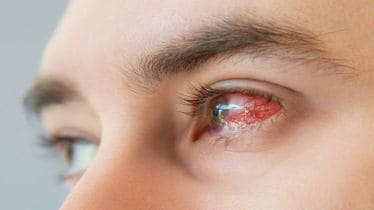Eye Flu in India: Cases of Conjunctivitis, also known as eye flu or pink eye, are rising across India. Amidst this surge in eye flu cases, the All India Institute of Medical Sciences (AIIMS) in Delhi is reporting approximately 100 cases per day.
According to doctors and health experts, a spike in conjunctivitis cases is usually observed during the monsoon season every year. However, there is an unusual rise in eye flu cases this year due to heavy, incessant rains and flooding.
“Unusual showers, flooding, and increased moisture in the atmosphere have contributed to a rise in conjunctivitis cases across the country. Since a lot of bacteria and viruses thrive in this season due to a rise in humidity and contamination of water, the cases are rising dramatically. Also, it generally affects more children than adults as they are the more vulnerable,” Dr Harshwardhan Ghorpade, Cornea, Cataract & Refractive Surgeon, Hiranandani Hospital, Vashi-A Fortis Network Hospital told Financial Express.com.
According to Dr Meenakshi Dhar, HOD, Dept of Ophthalmology, Amrita Hospital, Faridabad, the current acute conjunctivitis may be due to a viral infection (most likely adenovirus) or a bacterial infection. “Viral infections typically have watery discharge, while bacterial infections have yellowish/whitish discharge,” she said.
What are the symptoms of eye flu?
Some common symptoms of eye flu are:
- pain
- redness
- blurry vision
- swelling
- constant watering of the eyes
- stickiness of the eyelid
- fluid discharge
- crusting
- and sometimes blurring of vision.
“Although it tends to go away on its own, consulting a specialist is a good idea if the condition is extremely painful and going on for more than one week,” Dr. Ghorpade informed.
How is eye flu diagnosed and treated?
According to Dr. Ghorpade, treating conjunctivitis depends on the type of pink eye that a person is infected with.
“It is diagnosed based on the signs and symptoms after examination by the eye doctor with treatment methods including antibiotics, anti-inflammatory and lubricant eyedrops and ointments Placing a cold, wet cloth on the eyes may offer comfort in both cases,” he added.
There is a belief that wearing sunglasses and not looking at the infected person can stop the spread of infection. However, Dr. Ghorpade revealed that this is a myth as conjunctivitis cannot spread by looking into infected eyes.
“The best way to ensure its prevention and spread is by maintaining good hygiene habits and not using any items the infected person uses. This disease spreads by direct contact or through touching of items like towels, pillow covers, taps, door handles, etc.,” he pointed out.
But Dr. Dhar also pointed out that transmission occurs when the infective agent comes into contact with your eyes. “Infection can happen when infected hands touch the eyes. It’s wise to wear glasses as this will prevent unnecessary touching of the eyes,” she added.
What are the measures that infected people should take?
According to Dr. Dhar, infected individuals should take precautions to prevent the infection from spreading to other people around them. It’s important to keep the eyes clean and wash hands frequently, she revealed.
“Symptomatic treatment can be given including Ofloxacin/ Ciprofloxacin/ Chloramphenicol/ Tobramycin Eyedrops 3-4 times/ day, Decongestant Eyedrops like Mezol 2-3 times a day. Hot/ cold foamentation is helpful – boil both cotton and water for 10 min and cool it till it’s comfortable to put this wet cotton on your eyes. In severe cases, consulting a doctor is advised,” she told Financial Express.com.
He also emphasized that infected people should stay indoors as conjunctivitis is highly transmissible. “They should be isolated and follow a good diet to recover faster,” he added.
How to prevent eye flu?
Good hygiene practices are the best ways to avoid and stop the transmission of this disease. It includes:
- Whenever possible, avoid touching your eyes with unwashed hands.
- If you are a caregiver for an infected person, always clean the discharge properly with disposable sterile gauze and keep washing hands after handling the eyes for cleaning or putting drops.
- Always wash your hands often and thoroughly with soap and water, especially after coming from outside.
- Ensure you use clean tissues and towels to wipe your face and eyes.
- Do not share cosmetics, especially eyeliner or mascara, with others.
- Make sure that you always clean or replace your contact lenses. Also, if you have conjunctivitis, you should not wear contact lenses until they go away.
- Wash pillowcases frequently.
- Do not touch your eyes, Also do not share towels, and avoid putting water in the eyes or going for a swim.
- If you have consulted a specialist, take medication as prescribed.
“Also affected kids should not be sent to school till the eyes are red/ having discharge. Office goers should also work from home, if possible, to avoid spread in the workplace. Kids should also be counseled against touching of eyes/ face in school. Swimming should be avoided for the risk of contamination of pool water from an infected person. The prognosis of eye flu is usually good. Taking appropriate measures and treatment can help contain the spread of this epidemic,” Dr. Vanuli Bajpai, Consultant – Ophthalmology, HCMCT Manipal Hosiptal, Dwarka told Financial Express.com.
